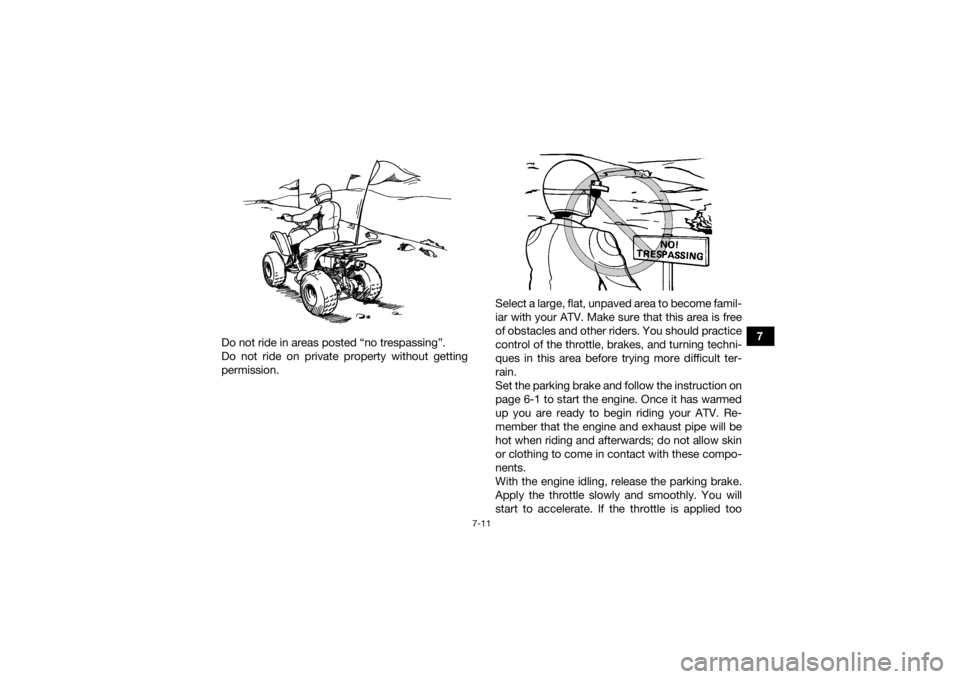Page 65 of 130

7-5
7
Pre-operation checks
Always inspect your ATV before use to make sure
that it is safe operating condition. Perform the pre-
operation checks listed on page 5-1. Follow the
maintenance schedules and procedures as de-
scribed in the “Periodic Maintenance and Adjust-
ment” section of this manual.
WARNING! Failure
to inspect the ATV before riding it or failure to
maintain it properly increases the possibility of
an accident and equipment damage.
[EWB01433]
Speed limiter
For beginning riders, riders less experienced with
this model, or whenever limited speed is desir-
able, the throttle lever housing is equipped with a vehicle speed limiter. The speed limiter keeps the
throttle from fully opening, even when the throttle
lever is pushed to the maximum. Turning in the
adjusting screw limits th
e maximum engine power
available and decreases the maximum speed of
the ATV. Turning in the adjusting screw decreases
top speed, and turning it out increases top speed.
(See page 4-3.)
This model also has an engine speed limiter plate
to limit the amount of engine power available.
Yamaha recommends that all beginning riders start off with the engine speed limiter plate in-
stalled and the vehicle speed limiter adjusting
screw turned in to limit the amount of speed avail-
able while they learn. The vehicle speed limiter
may be gradually adjusted to increase maximum
speed as the beginner becomes more familiar with
operating the ATV. Parents should decide when to
adjust the ATV for more power as their young-
ster’s riding skills improve. Once the ATV rider can
operate with skill at the top speed permitted by
adjusting the vehicle speed limiter alone, the en-
gine speed limiter plate can be removed. Since re-
moval of this plate will result in a significant
increase in power, turn the vehicle speed limiter
Page 66 of 130
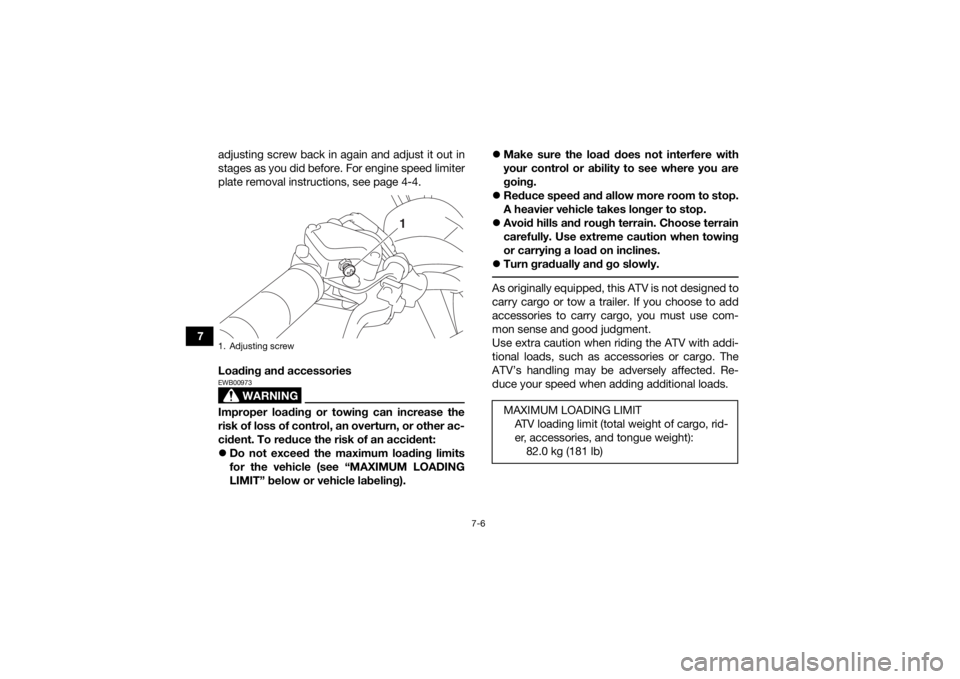
7-6
7adjusting screw back in again and adjust it out in
stages as you did before. For engine speed limiter
plate removal instructions, see page 4-4.
Loading and accessories
WARNING
EWB00973Improper loading or towing can increase the
risk of loss of control, an overturn, or other ac-
cident. To reduce the risk of an accident:
Do not exceed the maximum loading limits
for the vehicle (see “MAXIMUM LOADING
LIMIT” below or vehicle labeling).
Make sure the load does not interfere with
your control or ability to see where you are
going.
Reduce speed and allow more room to stop.
A heavier vehicle takes longer to stop.
Avoid hills and rough terrain. Choose terrain
carefully. Use extreme caution when towing
or carrying a load on inclines.
Turn gradually and go slowly.
As originally equipped, this ATV is not designed to
carry cargo or tow a trailer. If you choose to add
accessories to carry cargo, you must use com-
mon sense and good judgment.
Use extra caution when riding the ATV with addi-
tional loads, such as accessories or cargo. The
ATV’s handling may be adversely affected. Re-
duce your speed when adding additional loads.
1. Adjusting screw
1
MAXIMUM LOADING LIMIT
ATV loading limit (total weight of cargo, rid-
er, accessories, and tongue weight):82.0 kg (181 lb)
Page 67 of 130

7-7
7
During operation
Always keep your feet on the footboards during
operation; otherwise, they may contact the rear
wheels.
WARNING! Removing even one hand or
foot can reduce your ability to control the ATV
or could cause you to lose your balance and
fall off of the ATV. If you remove a foot from a
footboard, your foot or leg may come into con-
tact with the rear wheels, which could injure
you or cause an accident.
[EWB01472]
Avoid wheelies and jumping. WARNING! At-
tempting wheelies, jumps, and other stunts in-
creases the chance of an accident, including an overturn. Never attempt stunts, such as
wheelies or jumps. Don’t try to show off.
[EWB01482]Modifications and accessories
Never modify this ATV through improper installa-
tion or use of accessories or other modification. All
parts and accessories added to this ATV should
be genuine Yamaha or equivalent components
designed for use on this ATV and should be in-
stalled and used according to instructions. If you
have questions, consult an authorized ATV dealer.
WARNING! Operating this ATV with improper
Page 68 of 130
![YAMAHA YFM90 2017 Owners Manual 7-8
7modifications may cause changes in handling
which in some situations could lead to an acci-
dent.
[EWB01492]
Exhaust system
WARNING
EWB01502
Dry grass or brush or other combustible ma-
terial YAMAHA YFM90 2017 Owners Manual 7-8
7modifications may cause changes in handling
which in some situations could lead to an acci-
dent.
[EWB01492]
Exhaust system
WARNING
EWB01502
Dry grass or brush or other combustible ma-
terial](/manual-img/51/53791/w960_53791-67.png)
7-8
7modifications may cause changes in handling
which in some situations could lead to an acci-
dent.
[EWB01492]
Exhaust system
WARNING
EWB01502
Dry grass or brush or other combustible ma-
terial accumulated around the engine area
could catch fire. Do not operate, idle, or park
the ATV in dry grass or other dry ground cov-
er. Keep the engine area free of dry grass,
brush, or other combustible material.
Someone touching the exhaust system dur-
ing or after operation could be burned. Do
not touch the hot exhaust system. Do not
park the ATV in a place where others might
be likely to touch it. The muffler and other engine parts become ex-
tremely hot during operation and remain hot after
the engine has stopped. To reduce the risk of fire
during operation or after leaving the ATV, do not
let brush, grass and other materials collect under
the vehicle, near the muffler or exhaust pipe, or
next to other hot parts. Check under the vehicle
after operating in areas where combustible mate- rials may have collected. Do not idle or park the
vehicle in long dry grass or other dry ground cov-
er.
To prevent burns, avoid touching the exhaust sys-
tem. Park the ATV in a place where pedestrians or
children are not likely to touch it.
Page 69 of 130
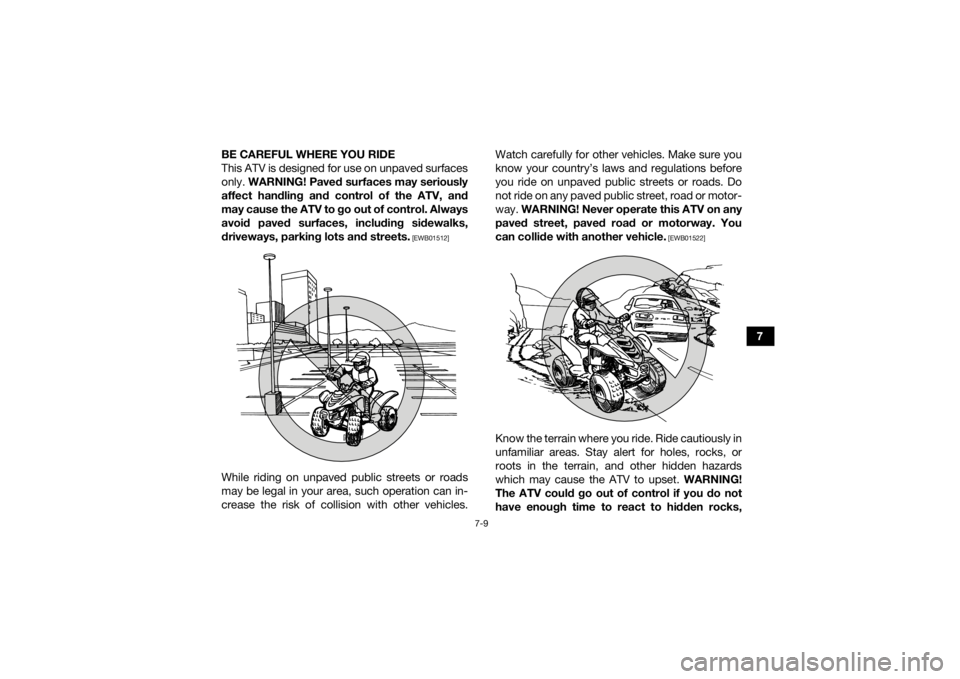
7-9
7
BE CAREFUL WHERE YOU RIDE
This ATV is designed for use on unpaved surfaces
only.
WARNING! Paved surfaces may seriously
affect handling and control of the ATV, and
may cause the ATV to go out of control. Always
avoid paved surfaces, including sidewalks,
driveways, parking lots and streets.
[EWB01512]
While riding on unpaved public streets or roads
may be legal in your area, such operation can in-
crease the risk of collision with other vehicles. Watch carefully for other vehicles. Make sure you
know your country’s laws and regulations before
you ride on unpaved public streets or roads. Do
not ride on any paved public street, road or motor-
way.
WARNING! Never operate this ATV on any
paved street, paved road or motorway. You
can collide with another vehicle.
[EWB01522]
Know the terrain where you ride. Ride cautiously in
unfamiliar areas. Stay alert for holes, rocks, or
roots in the terrain, and other hidden hazards
which may cause the ATV to upset. WARNING!
The ATV could go out of control if you do not
have enough time to react to hidden rocks,
UBD361E0.book Page 9 Monday, January 25, 2016 10:53 AM
Page 70 of 130
![YAMAHA YFM90 2017 Owners Manual 7-10
7bumps, or holes. Go slowly and be extra care-
ful when operating on unfamiliar terrain. Al-
ways be alert to changing terrain conditions
when operating the ATV.
[EWB01532]
Do not operate on rou YAMAHA YFM90 2017 Owners Manual 7-10
7bumps, or holes. Go slowly and be extra care-
ful when operating on unfamiliar terrain. Al-
ways be alert to changing terrain conditions
when operating the ATV.
[EWB01532]
Do not operate on rou](/manual-img/51/53791/w960_53791-69.png)
7-10
7bumps, or holes. Go slowly and be extra care-
ful when operating on unfamiliar terrain. Al-
ways be alert to changing terrain conditions
when operating the ATV.
[EWB01532]
Do not operate on rough, slippery, or loose terrain
until you have learned and practiced the skills nec-
essary to control the ATV on such terrain. Always
be especially cautious on these kinds of terrain.
WARNING! Failure to use extra care when op- erating on excessively rough, slippery, or loose
terrain could cause loss of traction or ATV con-
trol, which could result in an accident, includ-
ing an overturn.
[EWB01542]
When riding in an area where you might not easily
be seen, such as desert terrain, mount a caution
flag on the ATV. DO NOT use the flag pole bracket
as a trailer hitch. WARNING! You could collide
with another vehicle if operating in areas
where you cannot easily be seen. Mount a cau-
tion flag on the ATV to make you more visible.
Watch carefully for other vehicles.
[EWB01552]
UBD361E0.book Page 10 Monday, January 25, 2016 10:53 AM
Page 71 of 130
7-11
7
Do not ride in areas posted “no trespassing”.
Do not ride on private property without getting
permission. Select a large, flat, unpaved area to become famil-
iar with your ATV. Make sure that this area is free
of obstacles and other riders. You should practice
control of the throttle, brakes, and turning techni-
ques in this area before trying more difficult ter-
rain.
Set the parking brake and follow the instruction on
page 6-1 to start the engine. Once it has warmed
up you are ready to begin riding your ATV. Re-
member that the engine and exhaust pipe will be
hot when riding and afterwards; do not allow skin
or clothing to come in contact with these compo-
nents.
With the engine idling, release the parking brake.
Apply the throttle slowly and smoothly. You will
start to accelerate. If the throttle is applied too
UBD361E0.book Page 11 Monday, January 25, 2016 10:53 AM
Page 72 of 130

7-12
7abruptly, the vehicle may lurch forward or the front
wheels may lift off the ground, resulting in a loss of
directional control. Avoid higher speeds until you
are thoroughly familiar with the operation of your
ATV.
When slowing down or stopping, release the
throttle and apply the brakes smoothly and evenly.
Improper use of the brakes can cause the tires to
lose traction, reducing control and increasing the
possibility of an accident.
TURNING YOUR ATV
WARNING
EWB01772Always follow proper procedures for turning as
described in this Owner’s Manual. Practice
turning at low speeds before attempting to turn
at faster speeds. Do not turn at speeds too fast
for your skills or the conditions. ATV could go
out of control, causing a collision or overturn. To achieve maximum traction on unpaved surfac-
es, the two rear wheels turn together at the same
speed. Therefore, unless the wheel on the inside
of the turn is allowed to slip or lose some traction,
the ATV will resist turning. A special turning tech- nique must be used to allow the ATV to make
turns quickly and easily. It is essential that this skill
be learned first at low speed.
As you approach a curve, slow down and begin to
turn the handlebars in the desired direction. As
you do so, put your weight on the footboard to the
outside of the turn (opposite your desired direc-
tion) and lean your upper body into the turn. Use
the throttle to maintain an even speed through the
turn. This maneuver will let the wheel on the inside
of the turn slip slightly, allowing the ATV to make
the turn properly.UBD361E0.book Page 12 Monday, January 25, 2016 10:53 AM
 1
1 2
2 3
3 4
4 5
5 6
6 7
7 8
8 9
9 10
10 11
11 12
12 13
13 14
14 15
15 16
16 17
17 18
18 19
19 20
20 21
21 22
22 23
23 24
24 25
25 26
26 27
27 28
28 29
29 30
30 31
31 32
32 33
33 34
34 35
35 36
36 37
37 38
38 39
39 40
40 41
41 42
42 43
43 44
44 45
45 46
46 47
47 48
48 49
49 50
50 51
51 52
52 53
53 54
54 55
55 56
56 57
57 58
58 59
59 60
60 61
61 62
62 63
63 64
64 65
65 66
66 67
67 68
68 69
69 70
70 71
71 72
72 73
73 74
74 75
75 76
76 77
77 78
78 79
79 80
80 81
81 82
82 83
83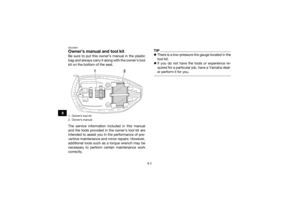 84
84 85
85 86
86 87
87 88
88 89
89 90
90 91
91 92
92 93
93 94
94 95
95 96
96 97
97 98
98 99
99 100
100 101
101 102
102 103
103 104
104 105
105 106
106 107
107 108
108 109
109 110
110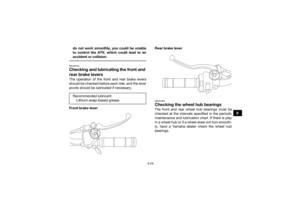 111
111 112
112 113
113 114
114 115
115 116
116 117
117 118
118 119
119 120
120 121
121 122
122 123
123 124
124 125
125 126
126 127
127 128
128 129
129


![YAMAHA YFM90 2017 Owners Manual 7-8
7modifications may cause changes in handling
which in some situations could lead to an acci-
dent.
[EWB01492]
Exhaust system
WARNING
EWB01502
Dry grass or brush or other combustible ma-
terial YAMAHA YFM90 2017 Owners Manual 7-8
7modifications may cause changes in handling
which in some situations could lead to an acci-
dent.
[EWB01492]
Exhaust system
WARNING
EWB01502
Dry grass or brush or other combustible ma-
terial](/manual-img/51/53791/w960_53791-67.png)

![YAMAHA YFM90 2017 Owners Manual 7-10
7bumps, or holes. Go slowly and be extra care-
ful when operating on unfamiliar terrain. Al-
ways be alert to changing terrain conditions
when operating the ATV.
[EWB01532]
Do not operate on rou YAMAHA YFM90 2017 Owners Manual 7-10
7bumps, or holes. Go slowly and be extra care-
ful when operating on unfamiliar terrain. Al-
ways be alert to changing terrain conditions
when operating the ATV.
[EWB01532]
Do not operate on rou](/manual-img/51/53791/w960_53791-69.png)
